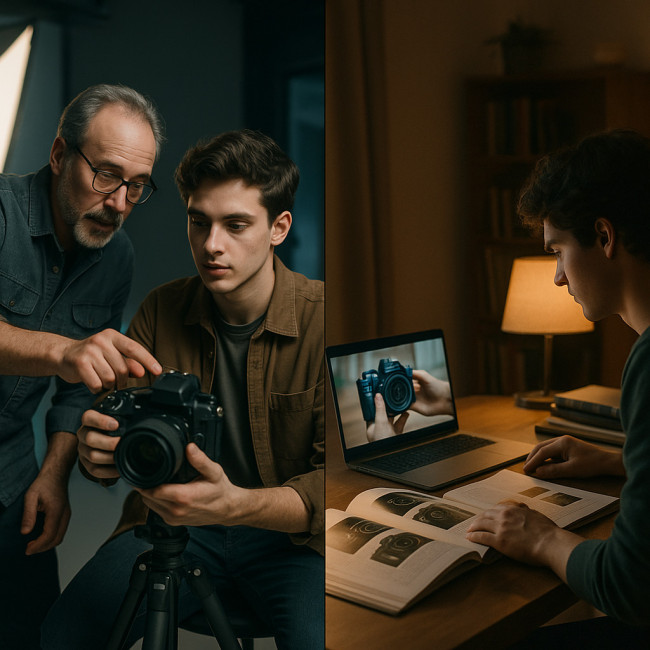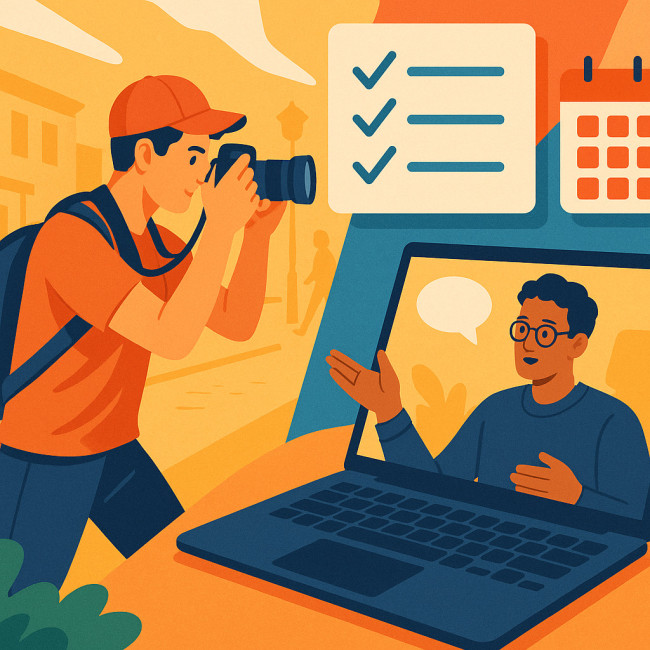Mentorship versus self-study: find the growth route matching your photo goals
Should you invest in a seasoned mentor or craft your own syllabus with books, podcasts and practice drills? This guide compares mentorship and self-study for photographers, helps you spot the best fit for your ambitions, and gives you a rapid decision framework so you can start improving today.
Why your learning path matters more than your lens choice

Gear upgrades feel tangible, yet the learning route you pick influences creative vision, booking power and long-term income far more. Whether you aim to refine lighting for luxury portraits or build a bold personal project that lands gallery shows, choosing mentorship versus self-study determines pace, network reach and confidence on set.
Mentorship: the personalised fast-track
Key upsides
- Instant feedback loops. A mentor spots technical slips—such as colour-cast shadows—before they fossilise into habit.
- Industry shortcuts. Many mentors open doors to assistants' lists, studio rentals or hidden casting pools, similar to those covered in our article on assistant roles that boost careers.
- Accountability. Scheduled reviews force you to deliver, beating procrastination that plagues solo learners.
- Tailored roadmaps. Lessons calibrate to your niche—wedding, still-life or sports—so every hour directly supports your business model.
Watch-outs
- Budget impact. Quality mentoring ranges from €80 to €250 per hour. Factor travel or online platform fees.
- Fit risk. Style mismatch can derail progress. Always request a portfolio critique trial before signing longer packages.
- Dependency. Relying on external validation can stunt self-diagnosis skills over time.
Self-study: the independent exploration path
Key upsides
- Cost control. Book bundles, MOOCs and podcast playlists (see our curated podcast list for photographers) deliver huge value for under €50 per month.
- Scheduling freedom. You shoot, read or watch tutorials when energy peaks, not when a mentor is available.
- Experiment breadth. Personal briefs encourage risk-taking without the subtle pressure to please a teacher.
Watch-outs
- Longer learning curve. Without external critique, uncovering blind spots—like micro-motion blur at 1/125s—takes months.
- Information overwhelm. Random YouTube dives create fragmented understanding.
- Networking gap. Solo paths lack built-in industry introductions that mentors often provide.
Mentorship vs self-study at a glance
| Factor | Mentorship | Self-study |
|---|---|---|
| Average monthly cost | €400–€1 000 | €30–€100 |
| Expected skill jump* in six months | ↑ 30 % portfolio quality | ↑ 15 % portfolio quality |
| Network expansion | High—access to mentor's clients | Low—requires proactive outreach |
| Schedule flexibility | Medium | High |
| Risk of plateau | Low | Medium–High |
*Based on aggregated survey data from European photo collectives, 2023.
Align your decision with clear photo goals
If you target rapid commercial bookings
Choose mentorship. A trusted pro can fine-tune your directory profile copy, mirroring the optimisation tactics we share in this directory profile guide. Faster profile upgrades convert into paid shoots sooner, offsetting mentor fees.
If you plan a long-term personal project
Self-study often suffices. Combine structured tutorials with a defined personal brief. Our walkthrough on building a personal photo project gives you a blueprint.
If you need portfolio diversity for agency work
A hybrid plan wins. Book three mentor sessions per quarter for feedback, then self-study lighting or colour theory between calls. Balance keeps costs predictable while ensuring direction.
Hybrid strategies that multiply results

Many top shooters combine both routes. They might join a six-week mentor sprint to master off-camera flash, then switch to self-guided practice for street projects. Another smart move is leveraging peer-led critique circles on training-focused photographer hubs where seasoned pros also mingle. You gain advice at community prices and expand reach in one click.
Rapid 15-minute decision framework
- List two short-term and two long-term goals. Examples: “book five corporate headshot gigs” or “exhibit in an art fair.”
- Estimate the skill gap. Rate each goal from 1 (small) to 5 (huge). Sum points.
- Match to route. 4–10 points = mentorship; 0–3 = self-study; 11+ = hybrid.
- Commit. Block calendar slots or message potential mentors today.
Ready to test yourself?
FAQ
- Can I switch from self-study to mentorship later?
- Absolutely. Many photographers start independently to grasp basics, then hire a mentor once they identify precise weaknesses.
- How do I vet a photography mentor?
- Ask for two recent mentee references, schedule a paid test critique, and review their teaching portfolio—not just their own images.
- What budget should I reserve for a one-year hybrid plan?
- Typical breakdown: €600–€1 200 for six mentor sessions plus €300 for books, online courses and peer-led portfolio reviews.
- Do mentors guarantee paid work?
- No mentor can promise bookings. They accelerate readiness; converting leads still depends on your marketing, pricing and client experience.
- Is self-study enough for high-end commercial photography?
- Often not. Complex lighting setups, large crews and strict brand guidelines favour those with guided experience to avoid costly mistakes.
Key takeaway & next step
Match your learning path to your goals, budget and timeline. If clarity still feels fuzzy, browse verified mentor profiles and peer study groups on Artfolio's photographer training marketplace, compare offers, and lock your first session or course while motivation is high.











